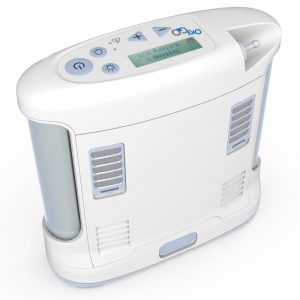Oxygen concentrators are electrical devices that filter the air to leave only oxygen; they are used in oxygen therapies.
How does oxygen therapy work?
There are two main types of oxygen equipment:
- Regular oxygen concentrators
- Portable oxygen concentrators (Portable oxygen concentrators work on batteries).
No matter which type you use, you get the oxygen through the nose, through soft plastic tubes. You can carry a portable oxygen concentrator with you, no matter where you go. On the other hand, stationary oxygen concentrators have an extendable tube (perimeter hose) that only allow you to move a little bit around, while being connected to the oxygen source. But both type provide the extra oxygen you need throughout the day.

How will you use oxygen in your daily life?
The recommended oxygen treatment must be respected to in order to obtain the benefits you expect from this therapy.
The oxygen flow is determined by your doctor based on blood gas test results. It is tailored to your needs to ensure the efficiency and safety of the treatment. You must not change it without your doctor’s consent. If you go through a long-term an adequately adjustment of oxygen flow while you rest, sleep or make physical effort will provide more benefits.
The doctor will prescribe the duration of the daily oxygen therapy. It will have the expected benefits under the right conditions of use. Integrating oxygen therapy into your daily routine not only can prolong your life, but can greatly improve it.
Do not feel embarrassed about using your portable oxygen concentrator in. There are millions of patients worldwide who undergo such a treatment. Besides, you can choose a portable oxygen system which is small, light and discreet.
Using oxygen will help you continue to do the things you enjoy. You will learn how to adapt to the use of this therapy equipment, and it will allow you to travel and make more and more physical effort, as you feel more comfortable with it.
Security rules
Oxygen accelerates the burning of any flammable material. There are some precautions related to using a oxygo portable oxygen concentrator, so make sure you consult the instructions provided by the manufacturer.
- Always keep the oxygen concentrator upright
- Do not smoke while using your concentrator
- Do not lubricate any parts of the oxygen concentrator
- Do not place the concentrator near a heat source
- Do not wear your portable concentrator underneath the clothes (coats, jackets). Avoid synthetic clothing fibers
Maintenance of the humidifying bowl
Clean the humidifying bowl once a week (use soap and rinse with water).
Change the water regularly (every 7 days) from the humidifier bowl. Always use demineralized, non-calcareous water.
Regular maintenance of the humidifying bowl helps you avoid the drying of the nose and mouth and any complications that may arise from this (e.g. nasal bleeding).
Special warnings
Ask your doctor if:
- You experience breathing difficulties during the oxygen treatment
- You notice an increased frequency of breathing while sitting down
- You have bronchial congestion (productive cough)
- You notice the appearance of cyanosis (blue lip color)
- You have fever or experience feet swelling

